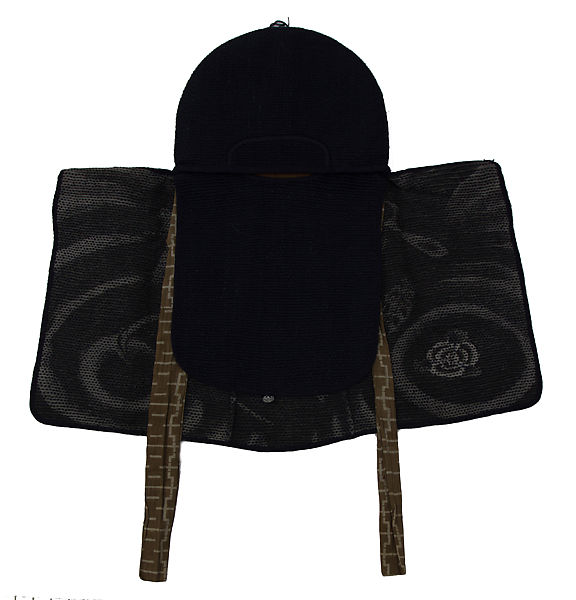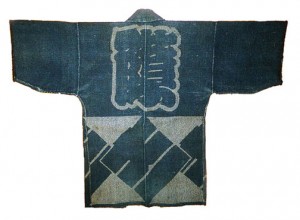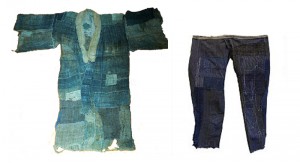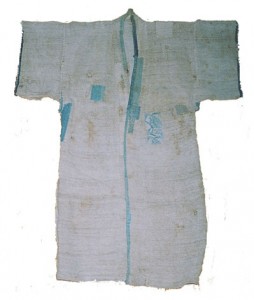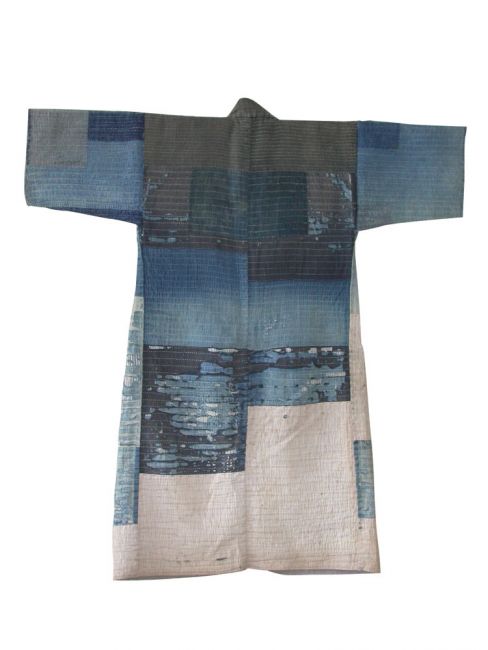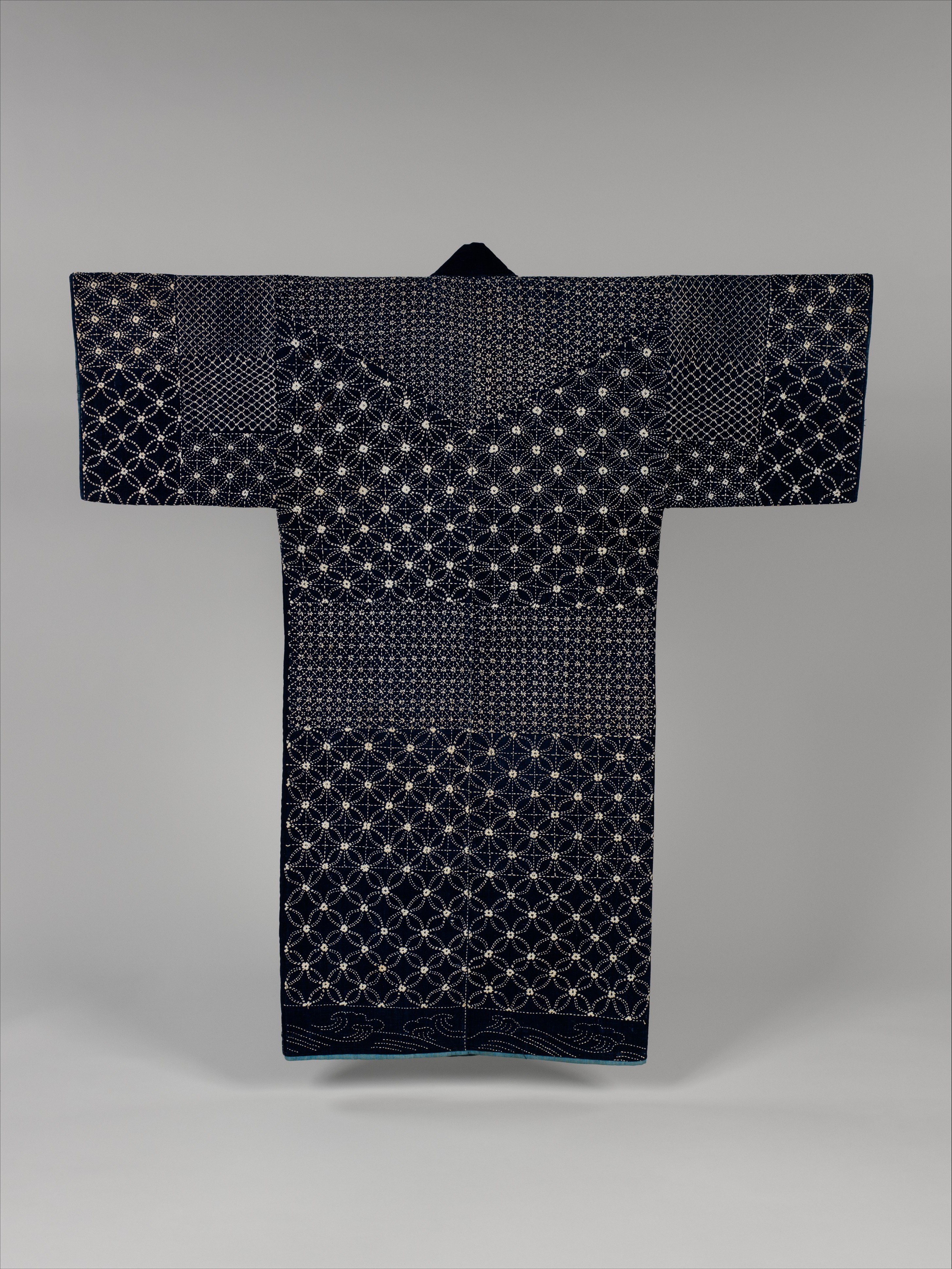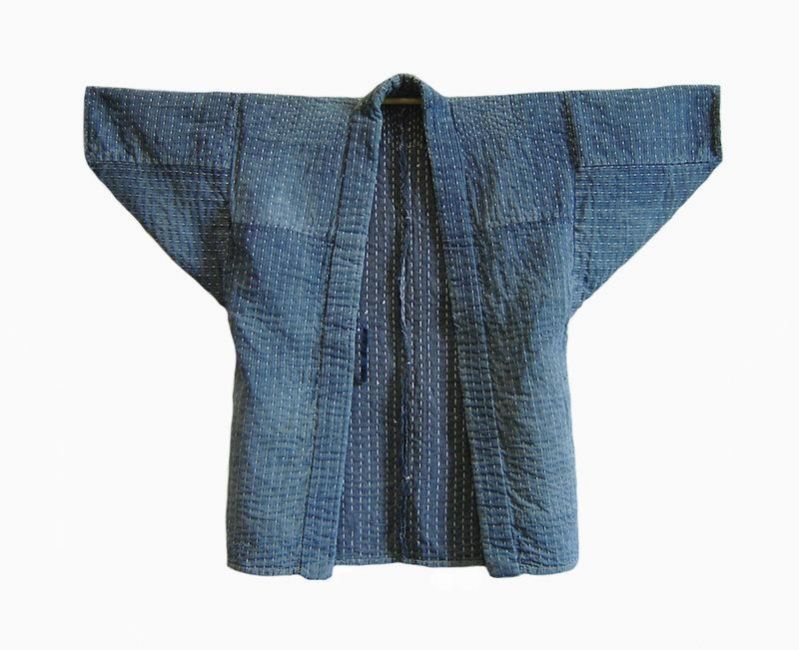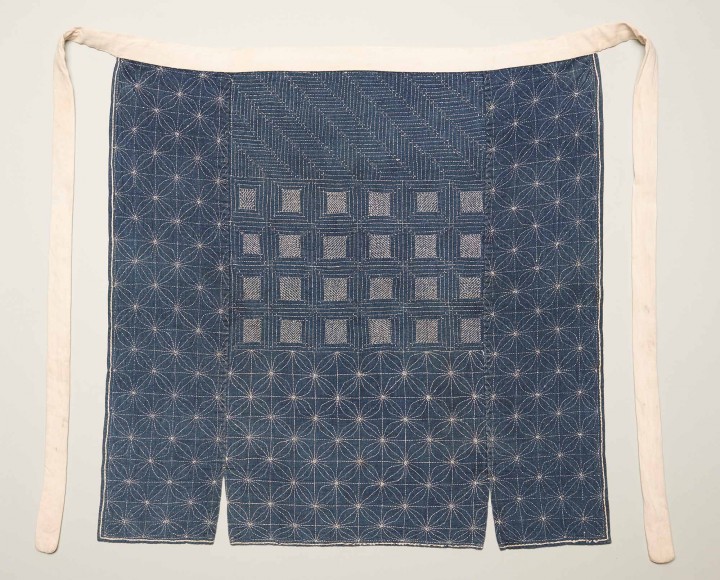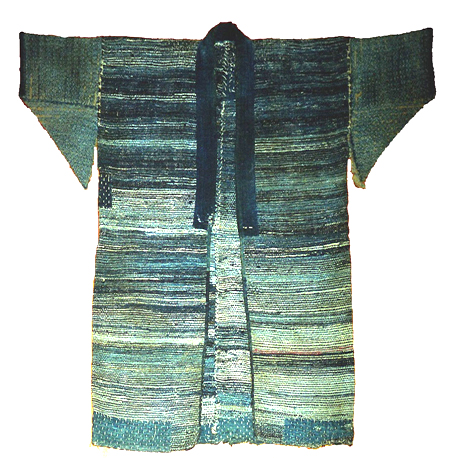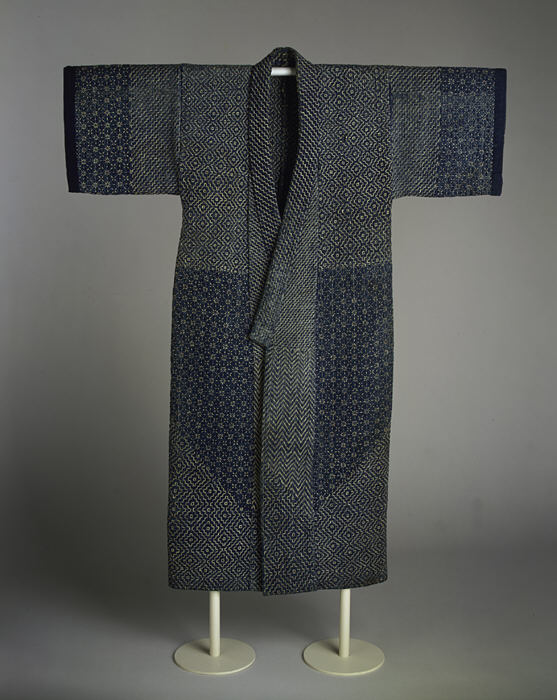The Technique
What process was/is used to make the design in general?
In all of these pieces (images 1-10), the Japanese have embroidered them with sashiko stitching. This technique started as a patchwork to fix worn out clothes and then slowly changed into elegant designs and patterns that express wealth in their society. Barbara S. Pickett, the author of “Sashiko: The Stitched Geometry of Rural Japan”, describes the design work to have started as a simple fix, but started becoming more artistic by creating geometric designs. Pickett describes the process as a simple hand stitch they used specifically for the worn out work clothes since they did not have money to get more fabrics. Once the Japanese people started making designs out of the stitching they tried to find ways of making them more complex by using grids to map out the designs on the fabrics. By using grids and math the designs started to take more labor and used more expensive materials like cotton to create elegant designs (Arai, 2006).
Is it surface, structural, or a combination?
Sashiko in the early stages of this technique could be considered as a combination of structural and surface design. Since it was used for mending the tattered textiles and making it stronger it could be considered as a component of the structure. As time progresses it became more of a surface design due to the design being applied after the garment is already created and is not being used for patchwork. This technique started out as patching of worn-out clothing and then evolved to designs and patterns that created art. In the article,” Sashiko Workshop: Experiential Geometry” by Lucy Arai, she talks about the patterns and how they are made from this technique. Arai describes the stitching process using grids and math by which the stitcher uses when creating complex designs.
What materials were/are used for the design?
Most of the clothes during these time periods were made out of hemp. Cotton was not brought to Japan until the 15th century.(The Japanese Folk Crafts Museum) The cotton was an expensive fiber so most Japanese still made their clothes with hemp and cotton was used in small pieces. Cynthia Shaver explained in her article, “Sashiko: A Stitchery of Japan“, That the technique and materials used varied by each region in Japan. The cotton was used for the sashiko style stitching to fix the worn spots on the hemp or ramie jackets and pants. The materials and cloth used were dyed and indigo color and then patched with the white cotton. This was not done until the upper class caught on to this trend and deemed it beautiful and valuable. Before that, the lower class would dye the entire piece Indigo to cover the patchwork because they would be looked down upon by the higher classes. (Kallal, 2016)
Who did the work?
Since this was originally used for fixing clothes and making sure nothing was wasted the people who originally wore this was the poor working class of Japan. The Japanese women stayed at home and took care of the house and children, so the women were the ones doing the embroidery stitching while their husbands were working. They also taught the young girls how to do this as well so when they grew up they would know how to fix clothing for their family. Another important factor to know about who was doing this work is what social class was this popular for. From the article, “Sashiko: A Stitchery of Japan” by Cynthia Shaver, it’s explained that the stitching is primarily done by women and it wasn’t known to have been done commercially. The technique was typically done in the lower and poor classes in Japan because they could not afford to buy new clothes. Shaver describes sashiko as a necessity rather than a luxury.
What was/is the purpose of the textile with this surface design?
The purpose of sashiko was originally a way to stitch up the holes or other tears in the textiles. Another reason for the lower and working classes to use this technique was so they could make their clothes not only stronger and more durable but to make them thicker and warmer. In the article, “Needle Exchange: Sashiko Stitching” by Penny Nickels, the firemen of these time periods also adopted sashiko stitching on their firesuits and hats. The reason behind this was because it not only made it thicker but also the textiles would be drenched in water before the men would enter the fire. This was to help keep them cool and fight off being caught on fire. As time went on this became a social status and fashion item. Since cotton was expensive the more cotton stitching and design you had on the clothing the richer you were. (Shaver, 1992 p. 271).
Is the technique still being carried out today by the culture? Do they still practice the technique, teach it, and produce objects with the technique?
In today’s culture, this technique is still being used not only on clothes, but on shoes, pottery, and bags. The Japanese are very prideful about their culture and love when others take interest in things they do. The Japanese not only teaches this technique to the youth but they tech people around the world how this technique is done and the history behind it. They also hold classes and seminars at the Japan Folk Crafts Museum. The Japanese teach them how to do the basic stitch work like on image 7 to fix holes, but also tech complex designs like on images 6, 8, and 10.
Popular Culture Today
How is this surface design or structural design or combination produced today?
The surface design of Sashiko uses fabrics, threads, and needles. Traditionally Sashiko used indigo dyed fabric, and white Sashiko thread. Sashiko is still produced today with these same techniques as it was traditionally done in the past.
Has the visual of the surface or structural design been used in material culture production today in popular culture or the fashion world?
yes, Sashiko technique is still being created by young designers who want to carry on the Japanese tradition.
Is it copied or used as inspiration?
The first imagine is taken from Vogue’s Resort Runway collection. The first question asked about Sashiko in popular culture today, “is it copied or used as inspiration.” In this collections piece Tadashi Shojis is inspired by his childhood memories, “of his mother stitching kimonos using the Sashiko embroidery technique.” (Vogue.com).
The second imagine example is The Up There X Saucony Grid 8000 Sashik, tennisshoe. In this collaboration with Saucony it is inspired by the traditional Japanese method known as Sashiko.
The third imagine demonstrating the use of Sashiko in popular culture today, is the soft Sashiko robe from the Blue Blue Japan collection by Sunjin. This coat was inspired by the traditional indigo dyes of Sashiko.
What materials are used in the production?
In the first imagine from Vogue’s Resort Runway Collection, the materials used in the production of Tadashi Shojis dress was the traditional indigo dyed fabrics, the white threads, and the geometric design.
In the second imagine The up there x Saucony grid 8000 Sashik, the materials used consisted of “indigo leather, and sashiko stitched upper, debossed tongue tags, supple leather inner soles, and sliver tipped waxed cotton laces.” (KicksOnFire).
In the third imagine the robe from blue blue japan collection, the materials used in this coat “are very light fabric… opposite of the stiff, hard wearing Sashiko fabric that were found in the men’s jacket.” (Journal.Styleforum). The fabric is thick, but moveable.
Where can it be purchased?
For the first imagine from Vogues Resort Runway Collection, you can purchase this dress on Tadashi Shoji official online boutique.
For the second imagine The up there X Saucony grid 8000 shoe you can purchase these at select Saucony retailers.
For the third imagine the robe from blue blue japan collection you can purchase the coat at the flagship store in Tokyo and it has the full range of products.
Who is producing it?
For the first imagine from Vogues Resort Runway Collection, designer Tadashi Shoji is producing the runway collection
For the second imagine The up there X Saucony grid 8000 shoe, Saucony the company is producing the shoes.
For the third imagine the robe from blue blue japan collection, designer Sunjin is producing the collection.
How much does it cost?
For the first imagine from Vogues Resort Runway Collection the dress cost around 800 dollars.
For the second imagine The up there X Saucony grid 8000 shoe cost 140 dollars.
For the third imagine the robe from blue blue japan collection, the robe cost around 435 dollars.
Legal/Moral Issues
END
Has the culture group who produced the technique you researched given permission for the use of their work with the examples discussed in Part II?
Since this technique started as a basic way of repairing clothes the Japanese have not governed the use of this technique. The technique, however, has been passed down from generations and is now taught worldwide. People from Japan often travel and teach classes and seminars to give a proper explanation of the history of sashiko, and how the basic stitching is done. This can be considered a way of giving permission from Japan by having the history and basics taught properly to other cultures who are wanting to learn this style of stitching. Sashiko is a freehanded type of stitch and you can create your own designs, having that known the Japanese do not dictate how a designer creates any patterns.
Discuss the laws that govern cultural intellectual property in the country where the culture resides.
Like the US, Japan has its own set of intellectual property laws, such as copyrights, trademarks, design, and patent acts. The World Intellectual Property Organization has the translated versions of these laws and states laws and acts to protect the Japanese culture and items they deem as a ‘national treasure’. Since sashiko is a stitching technique that has designed patterns designers can place a trademark or copyright a specific design/pattern they created, but not the stitching technique itself. International laws on copyrights and trademarks differ for every country. An example of this is if you have copyrights on a product or design in the US and you plan on expanding into other countries you must go and apply for the copyrights again.
What laws in the US govern cultural intellectual property?
There are four types of intellectual property, trade secrets, trademarks, copyrights, and patents. Intellectual property laws “deals with the rules for securing and enforcing legal rights to inventions, designs, and artistic work.” (IntellectualPropertyLaw).
Is the design considered sacred and should not be reproduced because of its sacred nature?
This type of stitching is not considered sacred, but it has been used on spiritual protection jackets from the mid 20th century like image 9 in part one. If this was a sacred design and technique the Japanese would consider it a ‘national treasure’ and have stricter laws on it. The Japanese would probably only use it for ceremonial use and have specific producers licensed to do this work.
Is the technique/visual representation of the culture’s work considered public domain?
Public domain “refers to creative materials that are not protected by copyright, trademark, patent, or any other intellectual property laws.” (ThePublicDomain) Sashiko is considered public domain, you can find temples and patterens to recreate the Sahsiko technique yourself. Sashiko the technique is public domain, designers or patterns created by designers can place trademarks on their own techniques.
